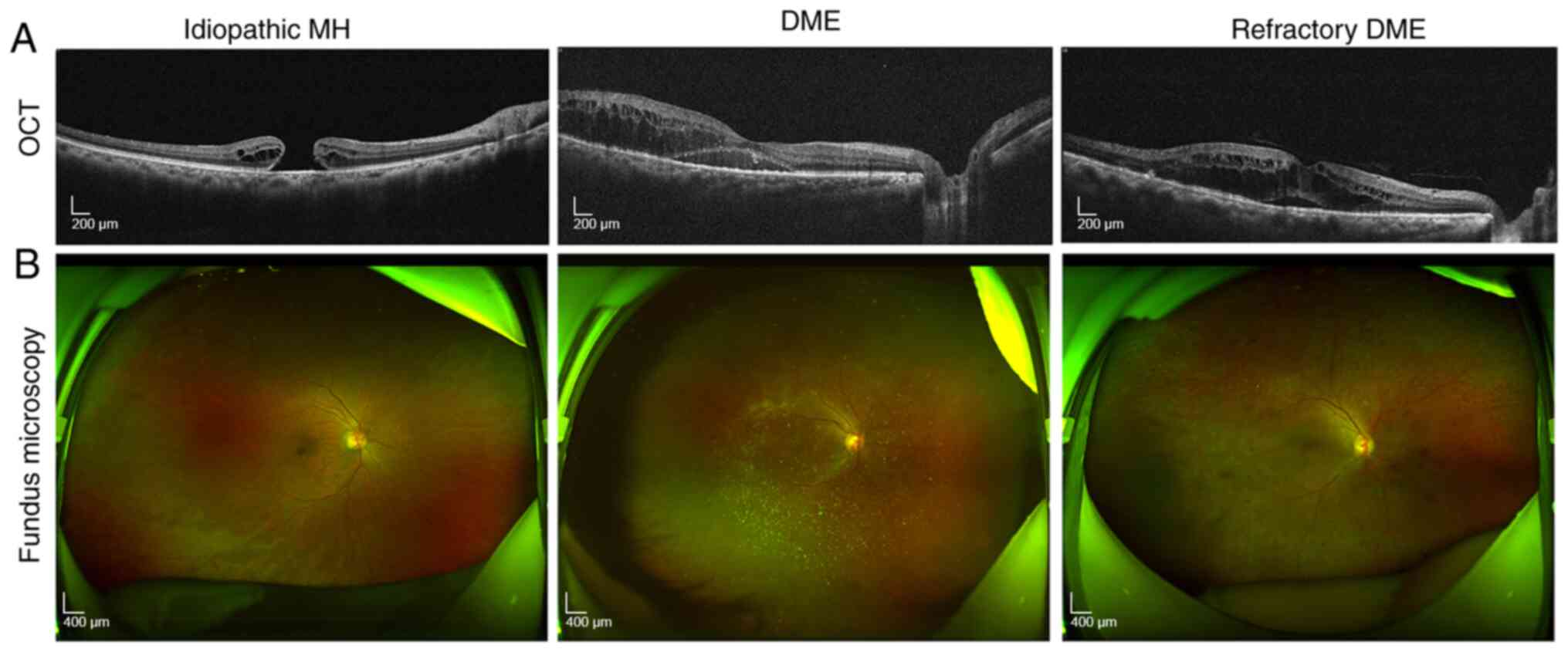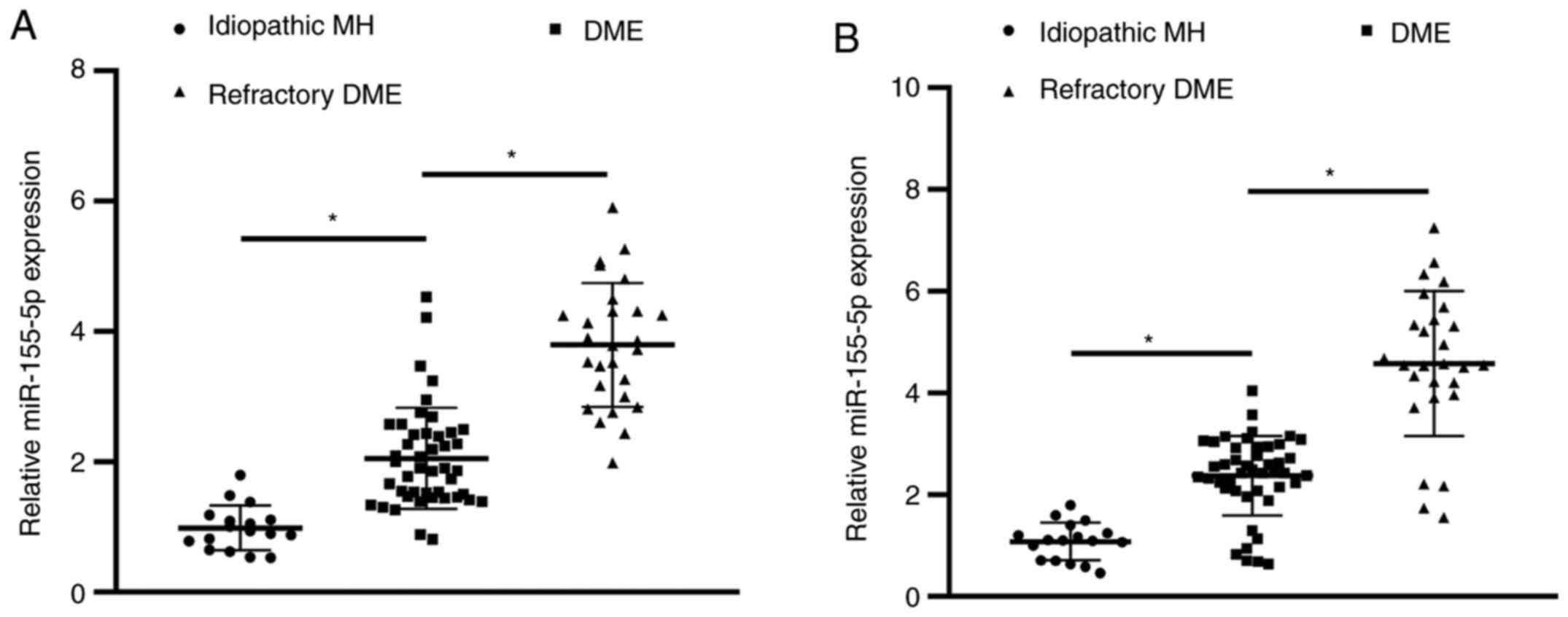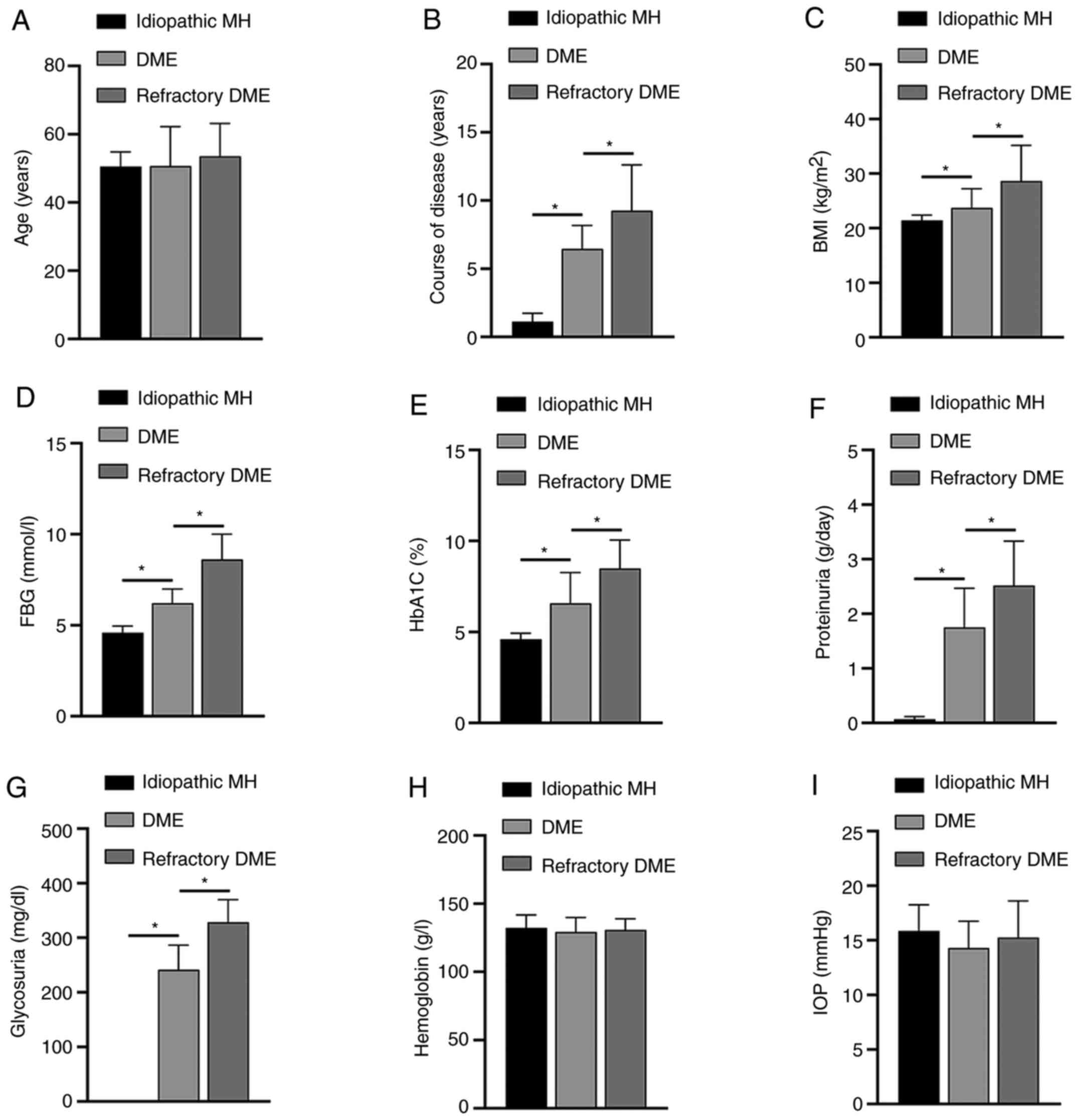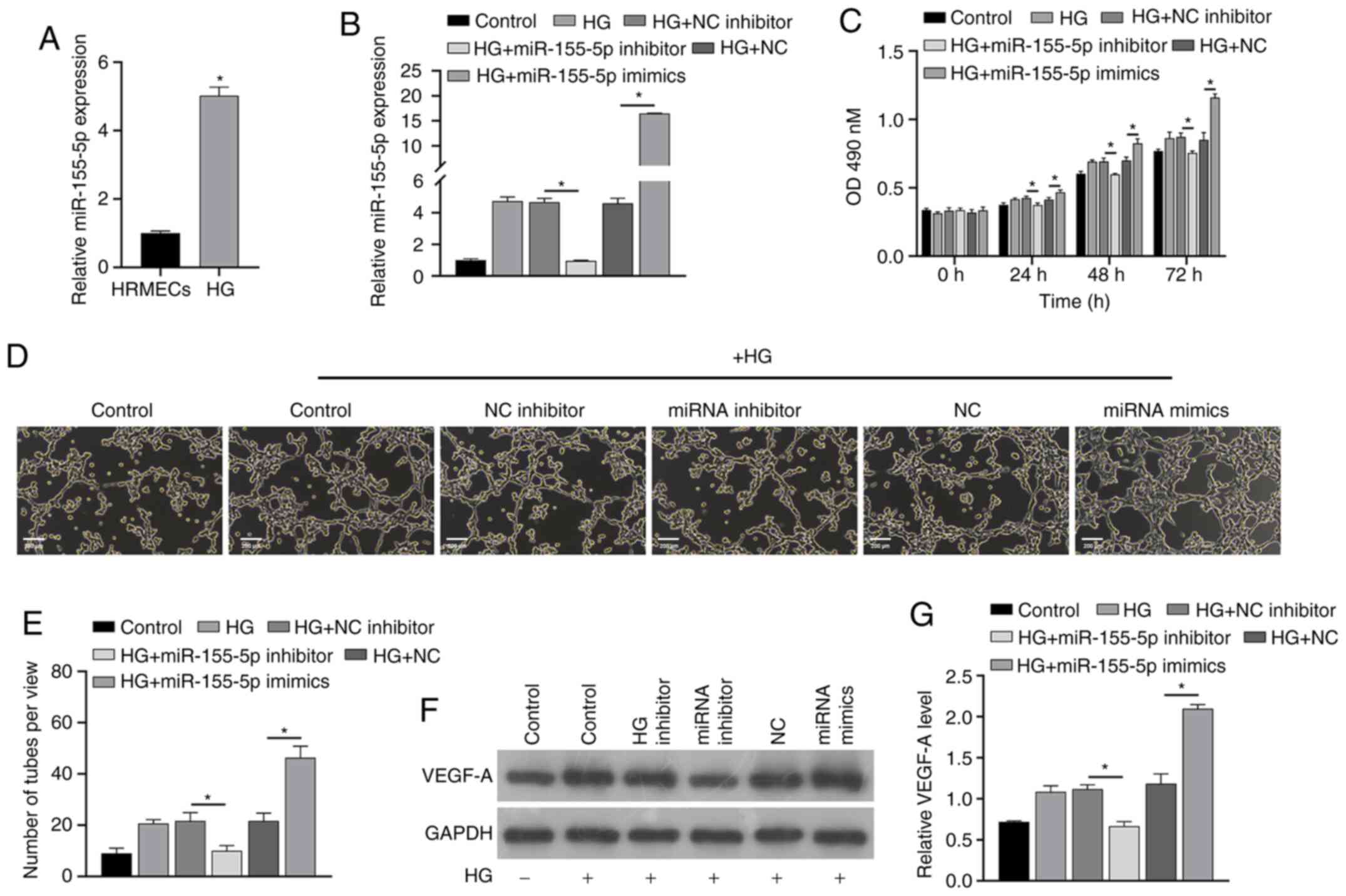|
1
|
Tan GS, Cheung N, Simó R, Cheung GC and
Wong TY: Diabetic macular oedema. Lancet Diabetes Endocrinol.
5:143–155. 2017.PubMed/NCBI View Article : Google Scholar
|
|
2
|
Patelli F, Radice P and Giacomotti E:
Diabetic macular edema. Dev Ophthalmol. 54:164–173. 2014.PubMed/NCBI View Article : Google Scholar
|
|
3
|
Yau JW, Rogers SL, Kawasaki R, Lamoureux
EL, Kowalski JW, Bek T, Chen SJ, Dekker JM, Fletcher A, Grauslund
J, et al: Meta-Analysis for Eye Disease (META-EYE) Study Group:
Global prevalence and major risk factors of diabetic retinopathy.
Diabetes Care. 35:556–564. 2012.PubMed/NCBI View Article : Google Scholar
|
|
4
|
Fenwick EK, Xie J, Man REK, Sabanayagam C,
Lim L, Rees G, Wong TY and Lamoureux EL: Combined poor diabetes
control indicators are associated with higher risks of diabetic
retinopathy and macular edema than poor glycemic control alone.
PLoS One. 12(e0180252)2017.PubMed/NCBI View Article : Google Scholar
|
|
5
|
Stana D, Potop V, Istrate SL, Eniceicu C,
Mihalcea AR, Paşca IG, Aqel A, Ciuluvică R and Moraru D:
Variability of diabetic macular edema in correlation with
hypertension retinopathy in patients with diabetes mellitus and
essential hypertension. Rom J Ophthalmol. 63:327–338.
2019.PubMed/NCBI
|
|
6
|
Romero-Aroca P, Baget-Bernaldiz M,
Pareja-Rios A, Lopez-Galvez M, Navarro-Gil R and Verges R: Diabetic
Macular Edema Pathophysiology: Vasogenic versus Inflammatory. J
Diabetes Res. 2016(2156273)2016.PubMed/NCBI View Article : Google Scholar
|
|
7
|
Shye M, Hanna RM, Patel SS, Tram-Tran N,
Hou J, Mccannel C, Khalid M, Hanna M, Abdelnour L and Kurtz I:
Worsening proteinuria and renal function after intravitreal
vascular endothelial growth factor blockade for diabetic
proliferative retinopathy. Clin Kidney J. 13:969–980.
2020.PubMed/NCBI View Article : Google Scholar
|
|
8
|
Kim JE, Pollack JS, Miller DG, Mittra RA
and Spaide RF: Isis Study Group. ISIS-DME: A prospective,
randomized, dose-escalation intravitreal steroid injection study
for refractory diabetic macular edema. Retina. 28:735–740.
2008.PubMed/NCBI View Article : Google Scholar
|
|
9
|
Hussain RM and Ciulla TA: Treatment
strategies for refractory diabetic macular edema: Switching
anti-VEGF treatments, adopting corticosteroid-based treatments, and
combination therapy. Expert Opin Biol Ther. 16:365–374.
2016.PubMed/NCBI View Article : Google Scholar
|
|
10
|
Grieco GE, Sebastiani G, Eandi CM, Neri G,
Nigi L, Brusco N, D'Aurizio R, Posarelli M, Bacci T, Benedetto E,
et al: MicroRNA Expression in the Aqueous Humor of Patients with
Diabetic Macular Edema. Int J Mol Sci. 21(21)2020.PubMed/NCBI View Article : Google Scholar
|
|
11
|
Chan HW, Yang B, Wong W, Blakeley P, Seah
I, Tan QS, Wang H, Bhargava M, Lin HA, Chai CH, et al: A pilot
study on MicroRNA profile in tear fluid to predict response to
anti-VEGF treatments for diabetic macular edema. J Clin Med.
9(9)2020.PubMed/NCBI View Article : Google Scholar
|
|
12
|
Wang J, Wang G, Liang Y and Zhou X:
Expression profiling and clinical significance of plasma MicroRNAs
in diabetic nephropathy. J Diabetes Res.
2019(5204394)2019.PubMed/NCBI View Article : Google Scholar
|
|
13
|
Bai X, Luo Q, Tan K and Guo L: Diagnostic
value of VDBP and miR-155-5p in diabetic nephropathy and the
correlation with urinary microalbumin. Exp Ther Med.
20(86)2020.PubMed/NCBI View Article : Google Scholar
|
|
14
|
Kim EJ, Lin WV, Rodriguez SM, Chen A, Loya
A and Weng CY: Treatment of diabetic macular edema. Curr Diab Rep.
19(68)2019.PubMed/NCBI View Article : Google Scholar
|
|
15
|
Lally DR, Shah CP and Heier JS: Vascular
endothelial growth factor and diabetic macular edema. Surv
Ophthalmol. 61:759–768. 2016.PubMed/NCBI View Article : Google Scholar
|
|
16
|
Miller K and Fortun JA: Diabetic Macular
Edema: Current understanding, pharmacologic treatment options, and
developing therapies. Asia Pac J Ophthalmol (Phila). 7:28–35.
2018.PubMed/NCBI View Article : Google Scholar
|
|
17
|
Zeng Y, Cui Z, Liu J, Chen J and Tang S:
MicroRNA-29b-3p promotes human retinal microvascular endothelial
cell Apoptosis via blocking SIRT1 in diabetic retinopathy. Front
Physiol. 10(1621)2020.PubMed/NCBI View Article : Google Scholar
|
|
18
|
Han N, Xu H, Yu N, Wu Y and Yu L:
MiR-203a-3p inhibits retinal angiogenesis and alleviates
proliferative diabetic retinopathy in oxygen-induced retinopathy
(OIR) rat model via targeting VEGFA and HIF-1α. Clin Exp Pharmacol
Physiol. 47:85–94. 2020.PubMed/NCBI View Article : Google Scholar
|
|
19
|
Qiu F, Tong H, Wang Y, Tao J, Wang H and
Chen L: Inhibition of miR-21-5p suppresses high glucose-induced
proliferation and angiogenesis of human retinal microvascular
endothelial cells by the regulation of AKT and ERK pathways via
maspin. Biosci Biotechnol Biochem. 82:1366–1376. 2018.PubMed/NCBI View Article : Google Scholar
|
|
20
|
Wang L, Liu WX and Huang XG:
MicroRNA-199a-3p inhibits angiogenesis by targeting the
VEGF/PI3K/AKT signalling pathway in an in vitro model of diabetic
retinopathy. Exp Mol Pathol. 116(104488)2020.PubMed/NCBI View Article : Google Scholar
|
|
21
|
Wilkinson CP, Ferris FL III, Klein RE, Lee
PP, Agardh CD, Davis M, Dills D, Kampik A, Pararajasegaram R and
Verdaguer JT: Global Diabetic Retinopathy Project Group. Proposed
international clinical diabetic retinopathy and diabetic macular
edema disease severity scales. Ophthalmology. 110:1677–1682.
2003.PubMed/NCBI View Article : Google Scholar
|
|
22
|
Mastroleo I: Post-trial obligations in the
Declaration of Helsinki 2013: Classification, reconstruction and
interpretation. Developing World Bioeth. 16:80–90. 2016.PubMed/NCBI View Article : Google Scholar
|
|
23
|
Lu L, Lu Q, Chen W, Li J, Li C and Zheng
Z: Vitamin D3 Protects against diabetic retinopathy by inhibiting
high-glucose-induced activation of the ROS/TXNIP/NLRP3 inflammasome
pathway. J Diabetes Res. 2018(8193523)2018.PubMed/NCBI View Article : Google Scholar
|
|
24
|
Gu C, Draga D, Zhou C, Su T, Zou C, Gu Q,
Lahm T, Zheng Z and Qiu Q: miR-590-3p inhibits pyroptosis in
diabetic retinopathy by targeting NLRP1 and inactivating the NOX4
signaling pathway. Invest Ophthalmol Vis Sci. 60:4215–4223.
2019.PubMed/NCBI View Article : Google Scholar
|
|
25
|
Livak KJ and Schmittgen TD: Analysis of
relative gene expression data using real-time quantitative PCR and
the 2(-Delta Delta C(T)) method. Methods. 25:402–408.
2001.PubMed/NCBI View Article : Google Scholar
|
|
26
|
Bandello F, Battaglia Parodi M, Lanzetta
P, Loewenstein A, Massin P, Menchini F and Veritti D: Diabetic
macular edema. Dev Ophthalmol. 58:102–138. 2017.PubMed/NCBI View Article : Google Scholar
|
|
27
|
Korobelnik JF, Do DV, Schmidt-Erfurth U,
Boyer DS, Holz FG, Heier JS, Midena E, Kaiser PK, Terasaki H,
Marcus DM, et al: Intravitreal aflibercept for diabetic macular
edema. Ophthalmology. 121:2247–2254. 2014.PubMed/NCBI View Article : Google Scholar
|
|
28
|
Michalewska Z, Stewart MW, Landers MB III,
Bednarski M, Adelman RA and Nawrocki J: Vitrectomy in the
management of diabetic macular edema in treatment-naïve patients.
Can J Ophthalmol. 53:402–407. 2018.PubMed/NCBI View Article : Google Scholar
|
|
29
|
Simunovic MP, Hunyor AP and Ho IV:
Vitrectomy for diabetic macular edema: A systematic review and
meta-analysis. Can J Ophthalmol. 49:188–195. 2014.PubMed/NCBI View Article : Google Scholar
|
|
30
|
Jackson TL, Nicod E, Angelis A, Grimaccia
F, Pringle E and Kanavos P: Pars Plana Vitrectomy For Diabetic
Macular Edema: A Systematic Review, Meta-Analysis, and Synthesis of
Safety Literature. Retina. 37:886–895. 2017.PubMed/NCBI View Article : Google Scholar
|
|
31
|
Michalewska Z, Stewart MW, Landers MB III,
Bednarski M, Adelman RA and Nawrocki J: Response to Vitrectomy in
diabetic macular edema. Can J Ophthalmol. 54:403–404.
2019.PubMed/NCBI View Article : Google Scholar
|
|
32
|
Choi MY, Jee D and Kwon JW:
Characteristics of diabetic macular edema patients refractory to
anti-VEGF treatments and a dexamethasone implant. PLoS One.
14(e0222364)2019.PubMed/NCBI View Article : Google Scholar
|
|
33
|
Maleki A, Stephenson AP and Hajizadeh F:
Topical interferon alpha 2b in the treatment of refractory diabetic
macular edema. J Ophthalmic Vis Res. 15:453–458. 2020.PubMed/NCBI View Article : Google Scholar
|
|
34
|
Mastropasqua R, Toto L, Cipollone F,
Santovito D, Carpineto P and Mastropasqua L: Role of microRNAs in
the modulation of diabetic retinopathy. Prog Retin Eye Res.
43:92–107. 2014.PubMed/NCBI View Article : Google Scholar
|
|
35
|
Chen CF, Hua K, Woung LC, Lin CH, Chen CT,
Hsu CH, Liou SW and Tsai CY: Expression profiling of exosomal
miRNAs derived from the aqueous humor of myopia patients. Tohoku J
Exp Med. 249:213–221. 2019.PubMed/NCBI View Article : Google Scholar
|
|
36
|
Wang G, Wu B, Zhang B, Wang K and Wang H:
LncRNA CTBP1-AS2 alleviates high glucose-induced oxidative stress,
ECM accumulation, and inflammation in diabetic nephropathy via
miR-155-5p/FOXO1 axis. Biochem Biophys Res Commun. 532:308–314.
2020.PubMed/NCBI View Article : Google Scholar
|
|
37
|
Assmann TS, Recamonde-Mendoza M, Puñales
M, Tschiedel B, Canani LH and Crispim D: MicroRNA expression
profile in plasma from type 1 diabetic patients: Case-control study
and bioinformatic analysis. Diabetes Res Clin Pract. 141:35–46.
2018.PubMed/NCBI View Article : Google Scholar
|


















